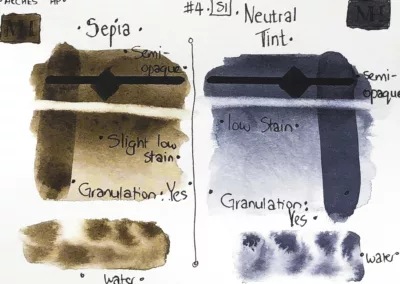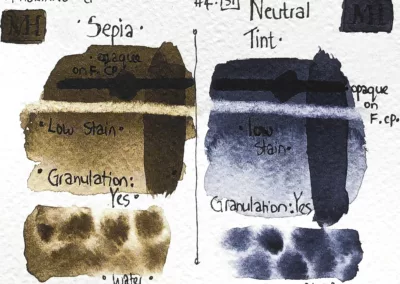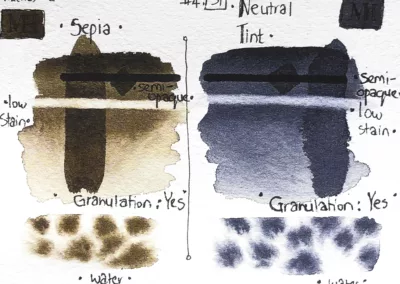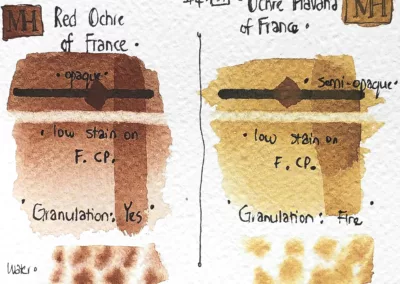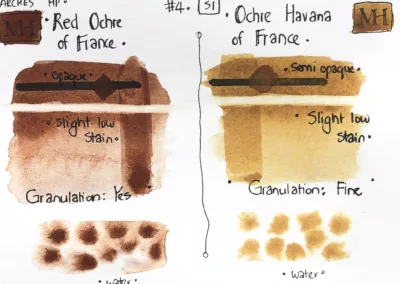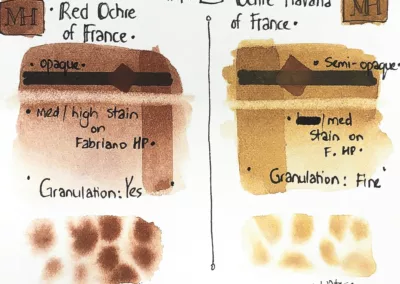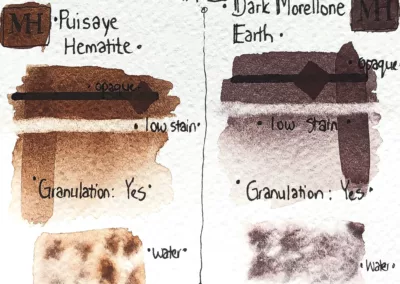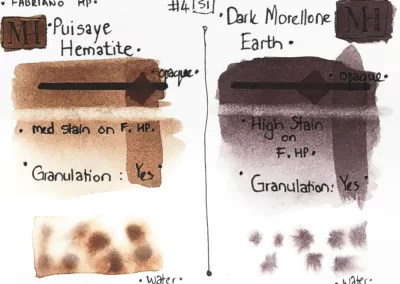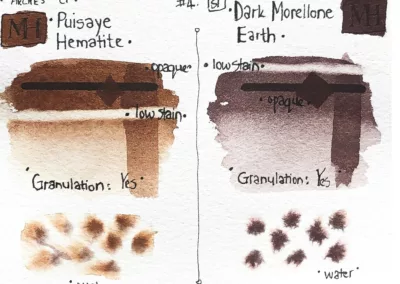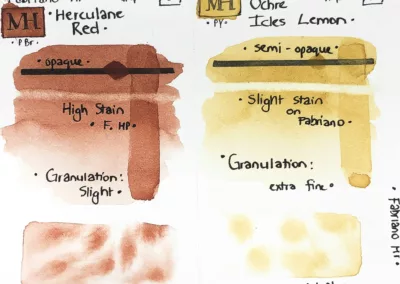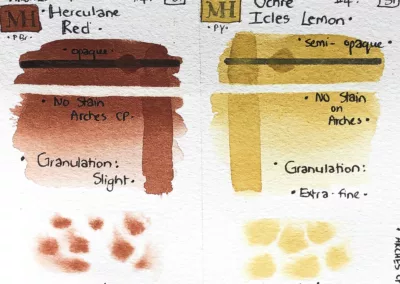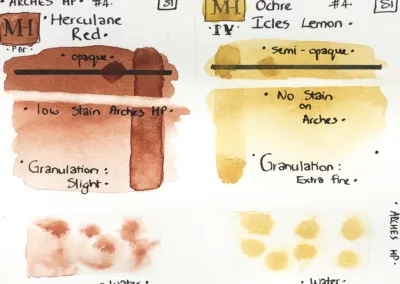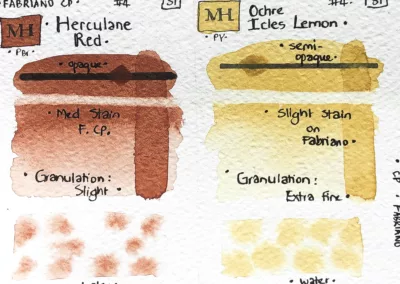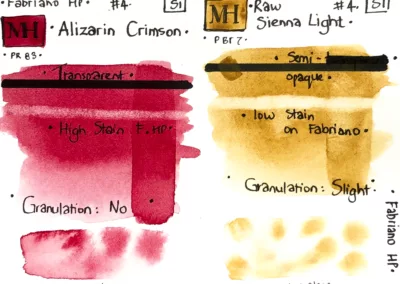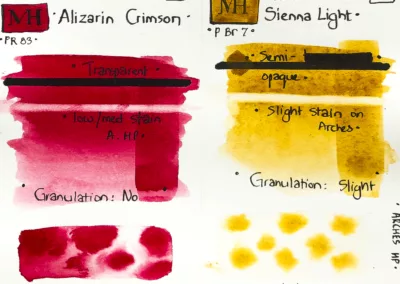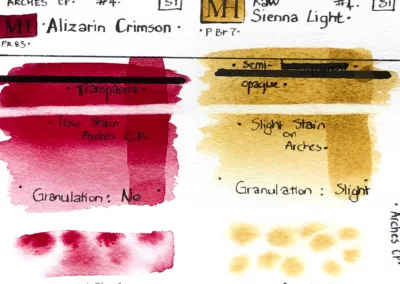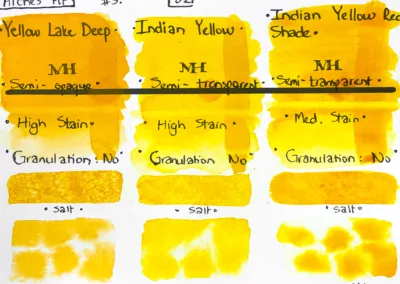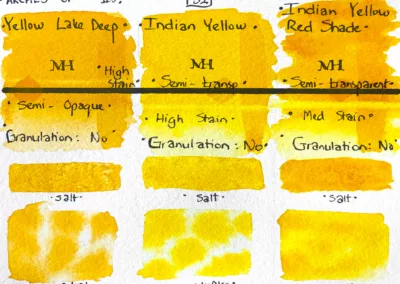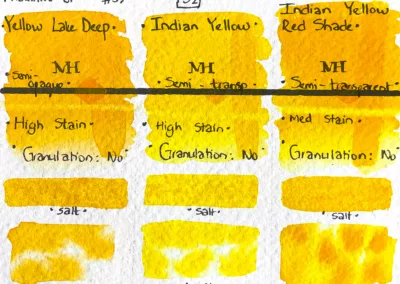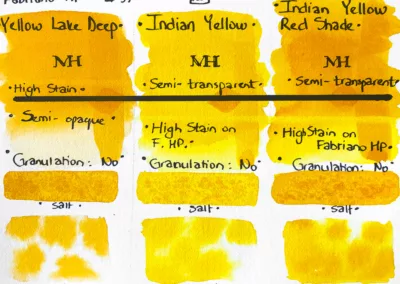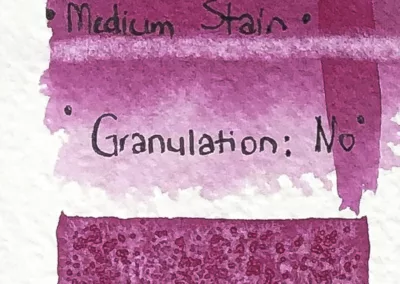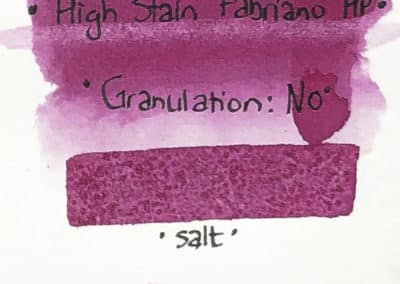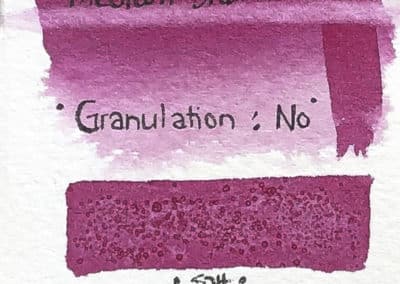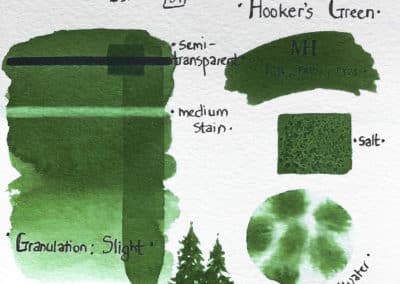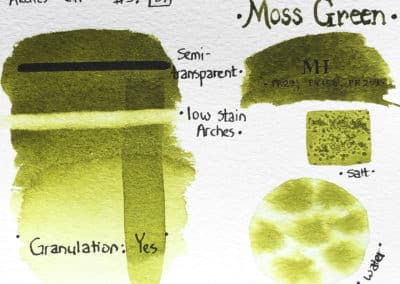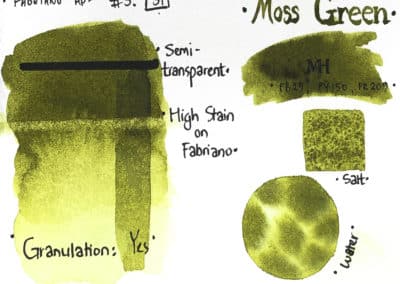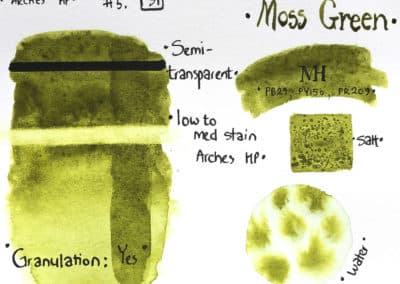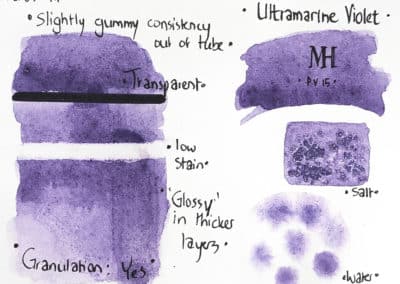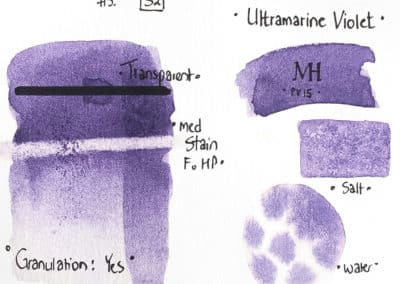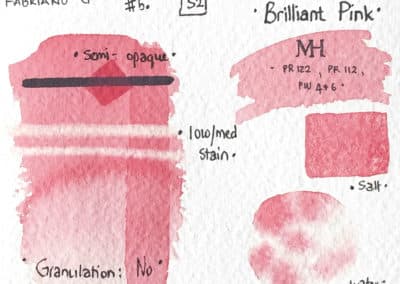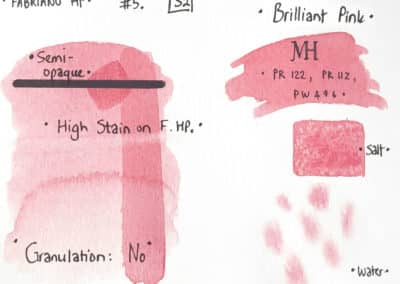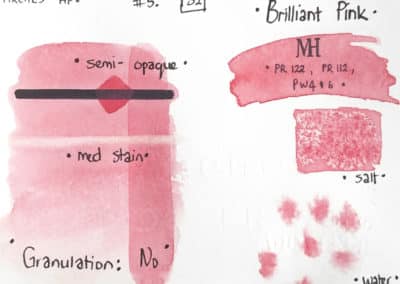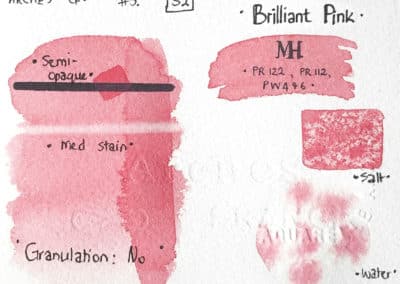FAQ – Watercolour:
Paints & Pigments
Question: Does MH exclusively use natural pigments in their watercolours? Are there any unique pigments that MH is known for, such as Lapis Lazuli?
Answer: MH offers a range of watercolours that include both natural and chemically created pigments. While we do utilize natural pigments in our watercolours, we also incorporate pigments that are synthetically produced. This combination allows us to provide a diverse palette of colours and achieve specific qualities in our paints. Additionally, MH is known for offering unique pigments, such as Lapis Lazuli, which adds a distinctive and vibrant blue hue to our watercolour collection. Lapis is one of the pigments we are known for in both our watercolour and oil product lines.
Question: Does MH also incorporate synthetic pigments in their paints? What advantages do synthetic pigments offer in watercolours?
Answer: Yes, MH incorporates synthetic pigments in their paints alongside natural pigments. Synthetic pigments offer several advantages in watercolours. Firstly, they often provide a more affordable option compared to natural pigments, making them accessible to a wider range of artists.
The use of synthetic pigments also allows artists to explore a broader spectrum of hues and achieve consistent colour results.
Question: Do MH watercolours contain any oils in their recipes?
Answer: No, MH watercolours do not contain any oils in their formulations.
Question: What factors affect the lightfastness of MH watercolours?
Answer: The lightfastness of MH watercolours is primarily influenced by two factors: the pigment strength and the absence of adulterants in the manufacturing process. MH watercolours are formulated without the addition of fillers, ensuring that only necessary ingredients are used. Additionally, the lightfastness of watercolours can also be influenced by the application technique, specifically how thinly or thickly the colour is spread. This principle applies not only to MH watercolours but to watercolours from other brands as well.
Question: Are paints with two or more pigments suitable for mixing with other colours?
Answer: Yes, paints that contain two or more pigments are indeed suitable for mixing with other colours. In fact, they can offer a broader range of colour possibilities and enhance the versatility of your painting palette. Paints with multiple pigments allow for more nuanced colour mixing and the creation of unique shades and tones. Whether you’re blending them with single-pigment paints or other multi-pigment paints, you can experiment and achieve a wide spectrum of colors by combining different paint hues.
Question: What should artists consider when mixing multi-pigment paints?
Answer: When working with multi-pigment paints, artists should consider several factors to achieve the desired results. One crucial aspect is understanding the principles of colour mixing. Familiarize yourself with colour theory, including primary, secondary, and tertiary colours, as well as complementary and analogous colour schemes. This knowledge will help you predict the outcomes of mixing different pigments and assist in achieving the desired hues.
Additionally, it’s important to be aware of the characteristics of each pigment in the multi-pigment paint. Some pigments may have a stronger tinting strength, meaning they can overpower or dominate the mix. Understanding the relative strength of pigments will allow you to adjust your mixing ratios accordingly.
Experimentation and practice are key when working with multi-pigment paints. Take the time to explore the behaviour of different combinations and observe how they interact. Keep a record of your experiments to build a personal reference guide for future use.
Lastly, consider the opacity or transparency of the pigments in the multi-pigment paint. Some pigments may be more transparent, while others are more opaque. This characteristic can influence the final result when mixing colours. Understanding the transparency of each pigment will help you achieve the desired effects in your artwork.
By considering these factors and gaining experience through practice, artists can harness the full potential of multi-pigment paints and create a wide range of vibrant and harmonious colours.
Question: Can you explain the nature of the granulation effect in MH watercolours?
Answer: The granulation effect in MH watercolours is a characteristic that is influenced by the types of pigments used. When certain pigments are present in the paint formulation, they have a tendency to separate and settle into distinct particles on the painting surface, creating a granular or textured appearance.
The granulation effect is not unique to MH watercolours alone. Pigments with the same colour index numbers across different brands of watercolours are expected to exhibit similar granulation properties. For example, if a particular pigment like lapis lazuli granulates in MH watercolours, it is likely to do so in other brands’ watercolour ranges as well.
The degree and intensity of granulation can vary depending on the specific pigment used and its characteristics. Some pigments tend to granulate more prominently, resulting in pronounced and textured effects, while others may exhibit minimal or no granulation at all.
Artists often embrace the granulation effect as it adds visual interest, texture, and depth to their watercolour paintings. By selectively utilizing pigments with known granulating properties, artists can create captivating and unique effects, enhancing the overall aesthetic appeal of their artwork.
Question: How does MH source natural pigments and are they ethically and environmentally conscious?
Answer: MH is committed to ensuring the ethical sourcing and environmental consciousness of the natural pigments used in our products. We have established long-standing relationships with our suppliers of raw materials, allowing us to carefully select pigments that align with our values. We prioritise sourcing pigments that are both ethically produced and environmentally friendly, ensuring that they are not obtained through unethical practices or harmful to the environment during the sourcing process. For more detailed information, please refer to our written statement on our website, which can be accessed here.
Question: How does MH maintain the consistency of pigment quality in their paints?
Answer: At MH, we take several measures to ensure the consistency of pigment quality in our paints. Firstly, we rely on our extensive experience and expertise in using the same pigments in our oil colours for over 40 years. This proven track record serves as a foundation for maintaining consistent quality.
Additionally, we employ a series of quality assurance processes during the manufacturing of our paints. These processes are designed to monitor and control the quality of pigments used. One such measure is the use of a UV-generating light box, which allows us to conduct accelerated stability tests on each pigment. This ensures that the pigments meet our standards for stability and performance.
By combining our years of experience, rigorous quality assurance processes, and accelerated stability testing, we are able to maintain a high level of consistency in the quality of pigments used in our paints.
Question: Can MH watercolours be used on different types of paper or surfaces?
Answer: MH watercolours are primarily designed for use on paper. However, it is important to note that different types of paper can yield varying results due to their composition and texture. For optimal performance, we recommend using our watercolours with Arches watercolour paper, as it has been found to deliver excellent results according to Michael’s preference.
That being said, individual artists may have different preferences and desired effects, so you may opt for other types of paper that align with your artistic goals.
Question: Can artists use MH watercolours for both professional artwork and hobbyist projects?
Answer: Absolutely! MH watercolours are suitable for artists of all levels, whether they are creating professional artwork or engaging in hobbyist projects. Our watercolours are designed to provide high-quality pigmentation, excellent colour vibrancy, and ease of use, making them versatile for a wide range of artistic endeavours. Whether you are a professional artist working on a commissioned piece or a hobbyist exploring your creativity, MH watercolours will meet your needs and deliver satisfying results.
Question: Are there any specific techniques or recommendations for using MH watercolours effectively?
Answer: Absolutely! When working with MH watercolours, there are a few techniques and recommendations that can help you achieve the best results.
Firstly, it’s important to note that MH watercolours have a higher pigment concentration compared to many other manufacturers. This means that a little goes a long way. Start with a small amount of paint and gradually build up the intensity and coverage as needed. This allows for better control over the colours and prevents over-saturation.
Additionally, experimenting with different brush techniques can enhance your artwork. Watercolour techniques such as wet-on-wet, wet-on-dry, glazing, and dry brushing can create various textures and effects. Don’t be afraid to explore and try different techniques to achieve the desired results.
Lastly, remember to use high-quality watercolour brushes and suitable watercolour paper for optimal performance. Investing in good materials will contribute to the overall outcome of your artwork.
By keeping these recommendations in mind, you can effectively harness the power of MH watercolours and create stunning and vibrant watercolour paintings.
Question: Can artists use MH watercolours for both professional artwork and hobbyist projects?
Answer: Yes! When working with MH watercolours, there are a few techniques and recommendations that can help you achieve the best results.
Firstly, it’s important to note that MH watercolours have a higher pigment concentration compared to many other manufacturers. This means that a little goes a long way. Start with a small amount of paint and gradually build up the intensity and coverage as needed. This allows for better control over the colours and prevents over-saturation.
Additionally, experimenting with different brush techniques can enhance your artwork. Watercolour techniques such as wet-on-wet, wet-on-dry, glazing, and dry brushing can create various textures and effects. Don’t be afraid to explore and try different techniques to achieve the desired results.
Lastly, remember to use high-quality watercolour brushes and suitable watercolour paper for optimal performance. Investing in good materials will contribute to the overall outcome of your artwork.
By keeping these recommendations in mind, you can effectively harness the power of MH watercolours and create stunning and vibrant watercolour paintings.
Question: Can MH watercolours be used in pans?
Answer: The current formulation of MH watercolours is not specifically made for pans. However, artists have the option to decant small amounts of paint from our 15 ml tubes into pans for daily use. It’s important to note that creating a pan formulation requires a different process, involving heating multiple layers of specially formulated paint that is then baked and layered. At this time, we have not begun the formulation process for pan-specific watercolours.
If artists are interested in using MH watercolours in pans, we recommend experimenting to see how they behave and perform in this format. Each artist’s preference and technique may vary, so it’s best to try and determine if the desired results are achieved when using MH watercolours in pans.
Question: Can artists use MH watercolours for both professional artwork and hobbyist projects?
Answer: The current formulation of MH watercolours is not specifically made for pans. However, artists have the option to decant small amounts of paint from our 15 ml tubes into pans for daily use. It’s important to note that creating a pan formulation requires a different process, involving heating multiple layers of specially formulated paint that is then baked and layered. At this time, we have not begun the formulation process for pan-specific watercolours.
If artists are interested in using MH watercolours in pans, we recommend experimenting to see how they behave and perform in this format. Each artist’s preference and technique may vary, so it’s best to try and determine if the desired results are achieved when using MH watercolours in pans.
Question: Will MH be producing pan watercolours in the future?
Answer: MH is currently evaluating its future product lineup, and the production of pan watercolours is one of the products on our list for evaluation. While we cannot provide a definitive answer at this time, we are actively considering the possibility of introducing pan watercolours to our product range. We understand the interest and demand for this format, and we will keep artists and customers updated on any developments regarding the availability of pan watercolours from MH.
Question: Does MH provide any information or resources on colour theory and mixing to assist artists in maximizing their use of the paints?
Answer: Yes, MH offers valuable resources and information on colour theory and mixing to help artists make the most of their paints. For oil paints, we recommend artists refer to Vicki Norman’s YouTube channel. Vicki Norman provides insightful tutorials and demonstrations on colour theory and mixing techniques specifically tailored for oil paints.
For watercolours, our ambassador for mixing is Marlaine Michie. Marlaine Michie shares her expertise and knowledge on colour theory and effective mixing techniques for watercolours. Artists can seek guidance and inspiration from Marlaine Michie’s insights to enhance their understanding of colour mixing in watercolour painting.
By utilizing these resources from Vicki Norman and Marlaine Michie, artists can gain valuable insights and techniques to enhance their understanding of colour theory and achieve desired results in their artwork.


